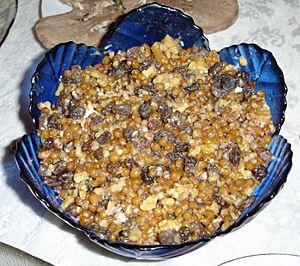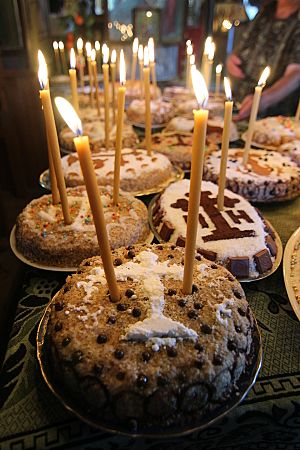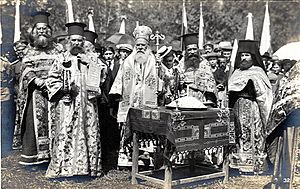Koliva facts for kids

Koliva from wheat seeds with raisins
|
|
| Alternative names | Kollyva, Colivă, Funeral Cake |
|---|---|
| Type | Ritual food |
| Main ingredients | Wheat kernels, honey or sugar |
Koliva is a special dish made from boiled wheat. It is used in the Eastern Orthodox Church to remember people who have passed away. You might also see it spelled as kollyva, kollyba, or colivă, depending on the language.
In the Eastern Orthodox Church, koliva is blessed during funerals. It is also used during special memorial services (called mnemosyno). These services happen at different times after someone dies. Koliva is also used on special days like the Saturday of Souls. In some countries, it's even eaten on non-religious occasions.
A similar food is popular in Lebanon. It's called snuniye or berbara. People prepare it for Saint Barbara's feast day on December 4. This day is celebrated with fun activities, a bit like Halloween.
Contents
What's in a Name?
The word kollyba comes from an old Greek word, kollybos. This word first meant a small coin or a tiny piece of gold. Later, it came to mean small pies made from boiled wheat. The idea of it being a special food for religious ceremonies came much later. In different countries, it has different names, like Koljivo in Serbian or Colivă in Romanian.
How to Make Koliva

The main ingredient for koliva is wheat kernels. These are boiled until they are very soft. Then, the wheat is drained well and spread out to dry a bit. After that, it's sweetened with honey or sugar.
Koliva can also have other tasty things added. These include sesame seeds, almonds, ground walnuts, cinnamon, pomegranate seeds, raisins, anise, and even parsley. In Romania, people often decorate their koliva with crosses made of cocoa, chocolate, or candy.
When koliva is served, it's often shaped into a small mound. This shape looks a bit like a grave. Then, it's covered with powdered sugar. Sometimes, the first letters of the person being remembered are written on top. A candle is usually placed in the middle of the koliva. It's lit at the start of the memorial service and put out at the end. After the service, people share the koliva. They talk about the person who passed away and say, "May God forgive him/her."
Sometimes, koliva is made with rice or barley instead of wheat. This started in Soviet Russia during a time when wheat was hard to find. People used rice so they could still make koliva. Some communities still use rice today. In the Japanese Orthodox Church, where rice is a main food, koliva is often made from rice with sugar and raisins.
Koliva's History
The idea of koliva is very old, even older than Christianity. The word kollybos itself comes from Ancient Greek. In ancient Greece, people offered a mix of cooked seeds and nuts during a festival called the Anthesteria. This was a pagan festival.
In the 5th century AD, boiled wheat, like koliva, was a common food for monks who chose not to eat bread. A church writer from the 12th century, Theodore Balsamon, said that the tradition of using koliva as a ritual food started with Athanasius of Alexandria. This was during the time of Emperor Julian the Apostate.
Koliva connects the ideas of death and life. It's like a seed planted in the ground that later grows into new life. This special food tradition moved from paganism to early Christianity in Byzantium. From there, it spread across the entire Orthodox world.
When Koliva is Used
Koliva is used on several different occasions:
St. Theodore Saturday
There's a tradition of blessing and eating koliva at the end of the first week of Great Lent. This tradition comes from a story about Julian the Apostate, a Roman Emperor. The Emperor knew Christians would be hungry after a week of fasting. He ordered that blood from pagan animal sacrifices be sprinkled on all the food sold in the markets of Constantinople. This made the food unsuitable for Christians, especially during Lent when they don't eat meat.
However, Saint Theodore Tyro appeared in a dream to Archbishop Eudoxius. He told the people not to buy food from the market that day. Instead, they should eat only boiled wheat mixed with honey. Because of this, the first Saturday of Great Lent is now known as Theodore Saturday.
Memorial Services
During special services to remember the dead (called Panikhida or parastas), the family or friends of the person who passed away often prepare koliva. It is placed in front of a special table where the service is held.
Memorial services are usually held on the third, ninth, and fortieth days after an Orthodox Christian dies. They are also held on the one-year anniversary. There are also several Soul Saturdays throughout the year, mostly during Great Lent. On these days, all departed Christians are remembered.
Funerals
Koliva is offered to everyone who attends funeral services in countries like Greece, Romania, Bulgaria, Serbia, and Russia.
Remembering Saints
In some Slavic traditions, koliva is also offered on the feast day of a church's or family's Patron saint. It's also used for saints who are very important. Instead of a memorial service, the koliva is placed in front of an icon of the saint. Then, a special prayer service called a Moleben is held for that saint.
In Lebanon, the Antiochian Orthodox community traditionally prepares koliva for the feast of Saint Barbara.
See also
 In Spanish: Koliva para niños
In Spanish: Koliva para niños



